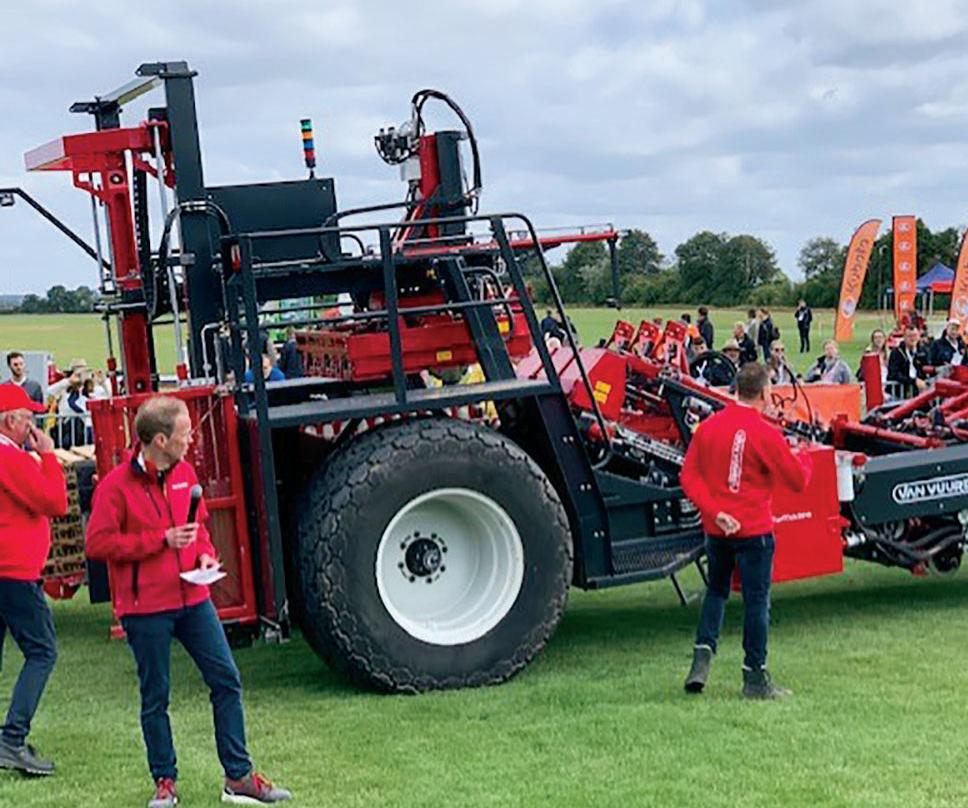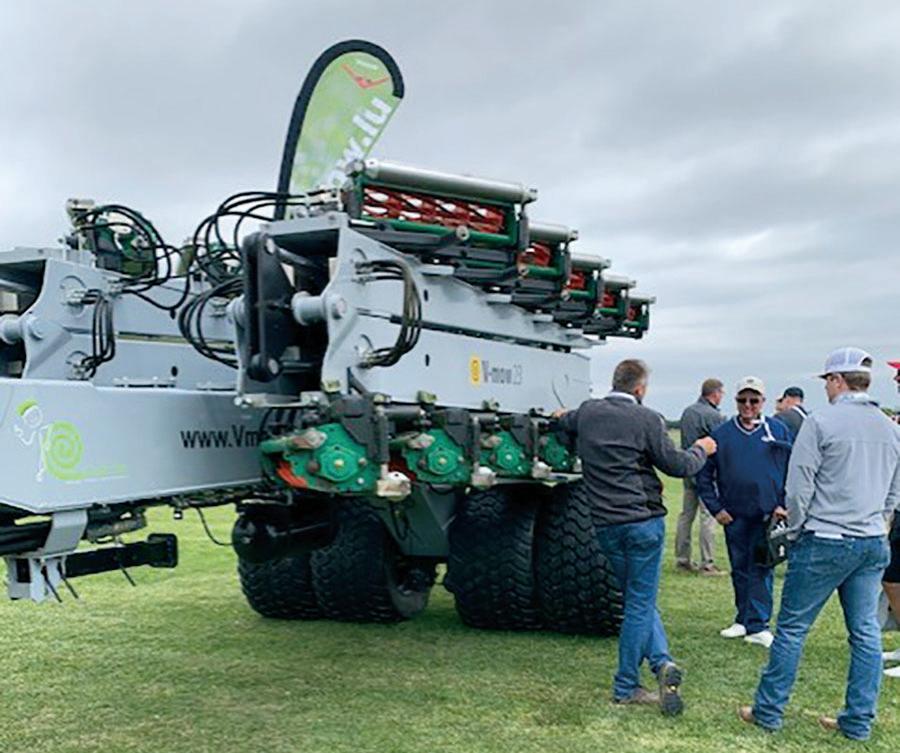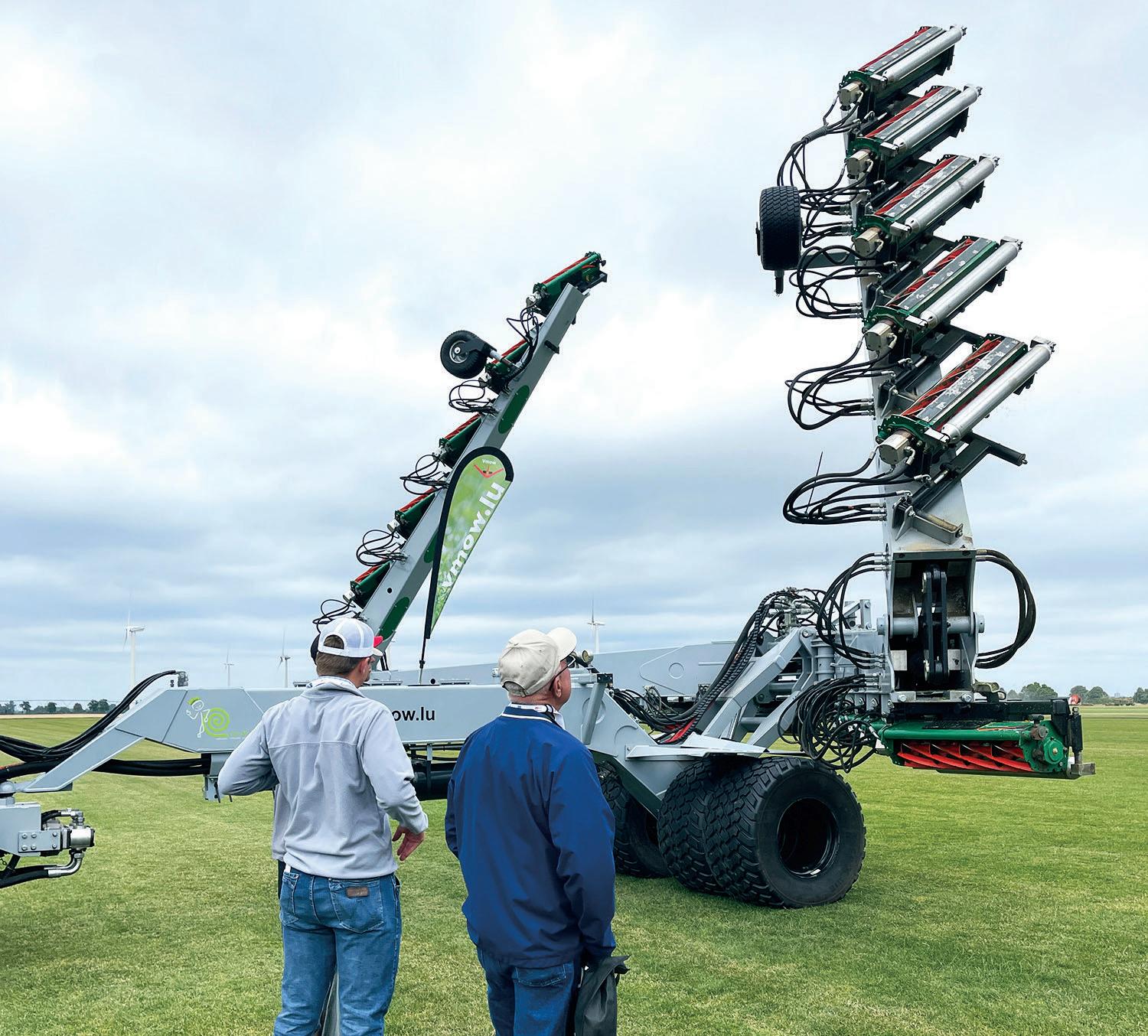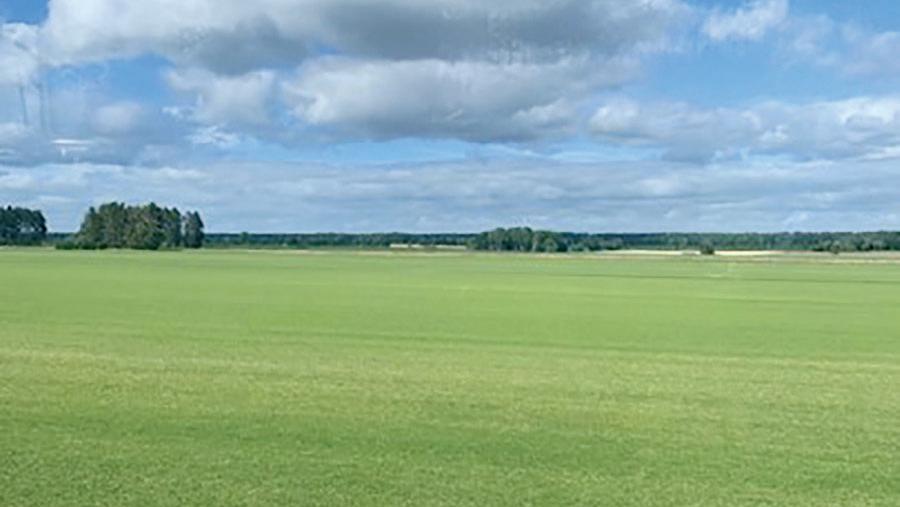
11 minute read
TPI Germany Trip Innovation and Technology Highlights
TPI GERMANY TRIP
INNOVATION AND TECHNOLOGY HIGHLIGHT
Compiled by Suz Trusty
As reported in the “TPI Germany Travel Diary” by Allie Shriver, TPI membership and marketing manager, who coordinated the trip, “With the help of European Turfgrass Producers (ETP) President and TPI Board Member Albrecht Knigge, a group of TPI members embarked on an excursion throughout the Lower Saxony region of Germany. At the core of the trip was participation in the ETP Expo, an educational field day and networking event that ETP holds every two or three years. The 2022 ETP Expo was held in Pattensen, Germany, on Albrecht’s farm, Rasenland Pattensener.” Additional visits to local enterprises provided even more opportunities to experience the culture and observe the innovation and technology incorporated into each of these family-owned enterprises. The TPI group toured Schloss Hamelschenburg, a revenue-generating castle; BOFERA – Der Rollrasen, a turfgrass production farm growing on clay; Ruheforst, a unique forest burial site; a multi-crop Knigge farming operation; and Matthies Landwirtschaft, a site with over 400 years of multi-crop farming.
Engineering and Innovation
John Coombs of Coombs Sod Farms, Elmer, New Jersey, reported, “The ETP Expo was held in Germany, but the association extends all across Europe, and those from many countries were exhibitors and attendees. I had always heard the European engineering was ahead of our U.S. engineering, and it looks like they were years ahead of us.” Bob McCurdy of McCurdy Sod Farms, Dyer, Tennessee, added, “The European engineering ability was obvious in all the equipment we saw.” Innovative mowers were a highlight for most of the attendees. John reported, “The blades on most of the rotary mowers were electrically driven. Because energy usage is very important, they are very energy conscious. With the electric power, they have fewer moving parts, so less to deal with in construction and later in maintenance.”
Wade Wilbur of Sod Shop, Lawrence, Kansas, said, “We have a couple of electric mowers that are readily used and available in the USA, but it seems the majority of the mowers at the ETP show were driven by a diesel tractor that was turning a generator. The electrical power created by the generator was then sent to electric motors that turned the blades. This method eliminates many belts and pulleys in the system.”
Ryan Menken of Jasperson Sod Farm, Union Grove, Wisconsin, noted, “Albrecht referenced the push for electrically driven motors due in part to the proximity of neighbors, to try to cut down on noise pollution. I thought that was unique.” Bob added, “A machine that we saw at BOFERA had the mower at the front and a generator at the back to provide the power to operate the mower. I saw that once at an event at Bobby Winstead’s in the early 2000s, but I’ve not seen it again in the U.S.” Ryan noted, “The front mounted mowers allowed them to mow in front of their tractor/implement before running down the grass. At times, the mower does not have enough suction to pick up the grass if it is run over before the mower cuts it.” Bob added, “With the mowers at the front of the tractor, the mower operator can see everything happening. Some of the mowers had a sweeper on the front, not to sweep away clippings or debris, but to stand the grass up before they mow it. Some of the equipment featured mowers on the front and back of the power unit and some of those could be set up in different configurations. About half of the mowers we saw had no skirts around the mowing units. So they dispersed the grass clippings over a wider area.” The reel mowers garnered attention, too. Bob noted airbrakes, heavy construction, and heavy-duty transport systems.
Other Equipment Highlights
Wade reported on the differences in seeders. “We have grass seed specific air seeders on the market in the USA, but in Europe, it seemed the majority of the farms were using air to transport the seed from the hopper to the ground.” John noted, “The big equipment, such as combines, used wider wheels or tracks, not the double sets of wheels we use in the U.S.”

Mower features drew attention, including heavy-duty construction. Photo by Bob McCurdy
Bob reported, “Their spray rigs had a large fan mounted on the back of the sprayer which used forced air to disperse the material. Those sprayers also had steerable axles in the back which gave them a tight turning radius at the end of the field.” Bob noted operation of a big irrigation unit different from what he’d seen in the U.S. “On ours, you pull the gun out. On this one, the hose is pulled out and the machine follows the hose, rolling up the hose as it travels the path laid out for it. (The rain train concept.) They could do a serpentine pattern with the hose, creating any path they wanted. The wheels drive the machine.”
And he was intrigued by the varied hooking systems used to connect tractors to other implements, noting pins and unusual stakes which were used like a drawbar is in the U.S. “Their implements hook to the tractor on the front with generators that are driven by the front-mounted PTO.” He also noted box or bucket attachments mounted on the front of a tractor or a forklift, making the machine a double-duty unit. Ryan reported, “The push for autonomous or self-controlled equipment in Germany seemed to be about the same as it is the U.S. They showed a commercial autonomous mower and had a charging station, too.” Bob commented on an autonomous mower, noting they operated it with a joystick. On autonomous tractors, Wade reported, “They had some prototype aftermarket devices in place that were operating their tractors without drivers. These devices are still in the experimental stage, but they were quite impressive.”
Roadway Regulations
A major issue of government regulation resonated with the TPI group. John said, “Another interesting bit of technology was how their big equipment was designed to comply with government regulations that nothing wider than three meters can travel on their roads. (Three meters is the equivalent of 9.84 feet.) The equipment was much wider than that when set up for working in the fields, some of it about 20 meters (over 60 feet), yet each machine had the capability to meet those requirements.” Ryan added, “Their innovation in design in making the large equipment small enough for transportation generally incorporated some type of folding system, but how that folding was accomplished varied.” Obviously, that mandate affects sod delivery. John reported, “To accommodate having to work with the narrower roads, their sod delivery is with 10-wheel trucks, often with the sod loaded on a flat-bed trailer pulled behind it.” Bob added, “They have lift gates, similar to what many of our delivery vehicles have, that they use when they deliver the sod curbside. We also saw forklifts with front forks about 96-inches (2.44-meters) long that were designed to carry two pallets of sod.”
Efficiency of Land Use
John reported, “In most of the places we saw, the farmhouses and farm buildings were in the villages, not on the farms. As you drive around our rural area, the farm buildings are on the farmland. In Germany, you can drive 20 to 30 miles (32 to 48 kilometers) and just see farm fields. So, they don’t travel far to get the machinery to the farmland, but they go often. It appeared that they took it home every night, where we might leave a machine in the field overnight if we’d be using it in the same field the next day.” Bob said, “The resourcefulness of the Germans in finding ways to use their resources to generate income really stood out for me. Their infrastructure is so old, and they have so much to maintain, there’s a never-ending need to find ways to finance the required maintenance. Owning property in Europe is such a privilege and ownership has been kept within families for so many years, it’s hard for others to

Innovative folding systems brought large equipment to within the threemeter roadway regulation. Photo by Ryan Menken
acquire it. Because the extended family jointly owns the land, they all share in the revenue the lands produce. That’s often what drew them into the sod business. They were looking for niche markets that could become another source of revenue.”
Efficiency of land use was a highlight for all of the group. Adam Russell of MVP Genetics, Cumming, Georgia, noted that was demonstrated at all the site visits. “These businesses are diversified to get the most out of their land and all the segments of their operations are very efficient. They’re going beyond basic crop rotation, combining regenerative ag and adaptive use ag to develop a second, third or fourth business. We saw radishes, sugar beets, wildflower seed, Christmas trees, and some traditional row crops, as well a turfgrasses, seven or eight different crops on one farm. We do see that in the U.S., but it’s not that widespread. In Germany, the focus on soil health and soil improvement seemed to the way of life in small and big operations. I didn’t hear anyone saying we don’t have great land.” The Knigge family Ruheforst demonstrated unique use of forest land as a burial site. Families could purchase a quadrant around a tree, or the entire tree, guaranteed for 99 years as a spot for the family ashes to be spread or buried in urns. Bob reported, “It’s a peaceful setting, well maintained, that the family can visit whenever they want.” Ryan added, “Because of the long history of overcrowding in European cemeteries, there’s a tremendous market for that service.”
Ryan pointed to another unique government mandate. “Based on the number of hectares they have in agricultural production; a certain percentage of their land must be set aside for native vegetation as an undisturbed natural habitat.” Bob reported the Matthies family found another revenue source in growing wildflowers to harvest and sell the seed. “Government regulations also dictate that they can’t plant certain plants outside of certain parameters. They winnow the seed inside their building to preserve the purity of the crop and to keep the seed contained. They look at the wildflower seed as gold; small quantities generate significant revenue.”

In most areas, farmhouses and farm buildings were in the villages, not on the farms. Photo by Bob McCurdy
Observing the Culture
Adam reported, “The countries felt like our states. The EU has few restrictive borders, and they do lots of country-tocountry commerce. Seeing all the countries represented, interacting, and networking at the ETP Expo, I was impressed by the lack of language barriers, how many people knew English, and how easily they could transition between languages to communicate effectively.” Bob reported, “They don’t have a long enough growing season to grow much grain. But we saw a covered pile of chopped corn which they were developing as silage. They burn the silage for fuel to generate power. They retain the ash to spread over the soil before the next planting.” John noted, “I’ve really noticed that in the U.S., when we’ve visited other sod producers, how many things were different, yet so many other things were the same. That was true on the Germany trip, too.” Ryan reported, “Just as in the U.S., every farm had their challenges. One had no irrigation system.” Bob noted, “The Europeans dealt with Covid-19 much as we did. We put a toolbox across the front door of our office. They made a walkup window to keep people out of the office. They kept their no contact system and we kept ours, finding it was a more efficient way to do business.” Tour members noted the retail centers they saw were wellorganized and very neat and clean. As in the U.S., some were offsite, not on the sod farm. Bob reported, “One center we visited had small sod cutters on display which they rented out as a revenue source. Labor issues are an international concern. At one visit, we saw a building that served as the living quarters for their foreign workers. They employed 42 of those workers, mostly Romanians, and providing the housing was part of the employment agreement.”
Growing Those TPI Connections
The group was unanimous in reporting that Allie Shriver and Albrecht Knigge did a great job of setting up and coordinating the trip.Wade expressed how much he enjoyed the trip and John reported, “It was a great experience and I’m very glad we did it.” And Bob added, “Being with that group made the trip special—there’s not a bad apple in the bunch.” Ryan noted, “TPI is like a huge extended family. Whether we’re touring a sod farm in the U.S. or in Germany, everyone is welcoming, very open, and accommodating. The networking is the biggest take away.” Adam said, “I encourage everyone to join in these international excursions. It’s a different level of absorption. The shared group experience draws everyone closer, making member connections even stronger. And a large group taking part in their event is a strong showing of support for our international members. It’s well worth the time, effort, and money.” port Suz Trusty is co-editor of Turf News.










